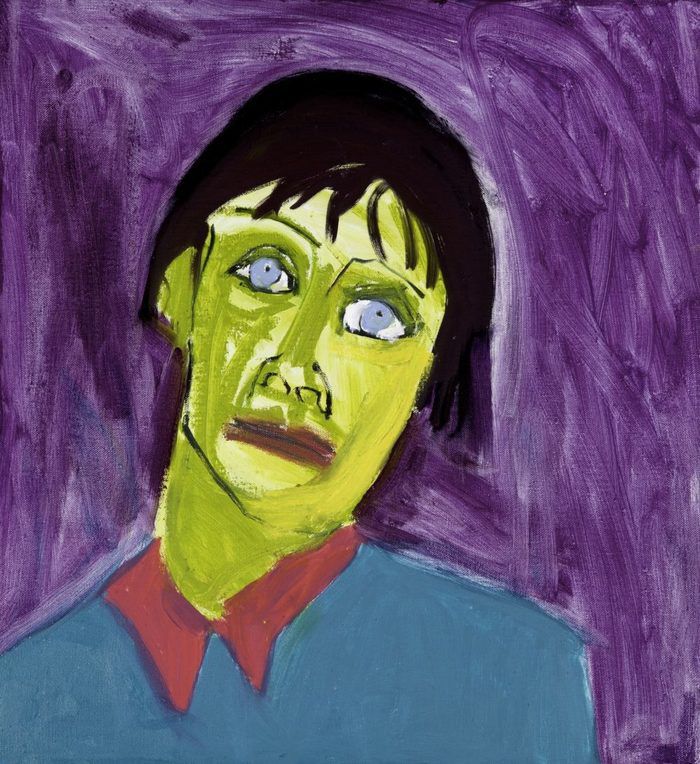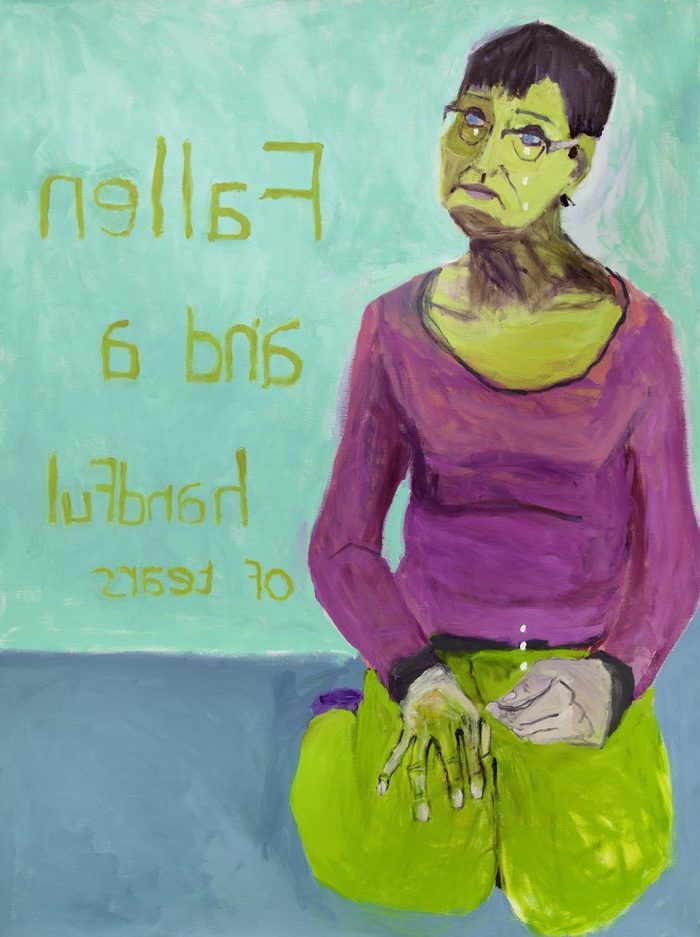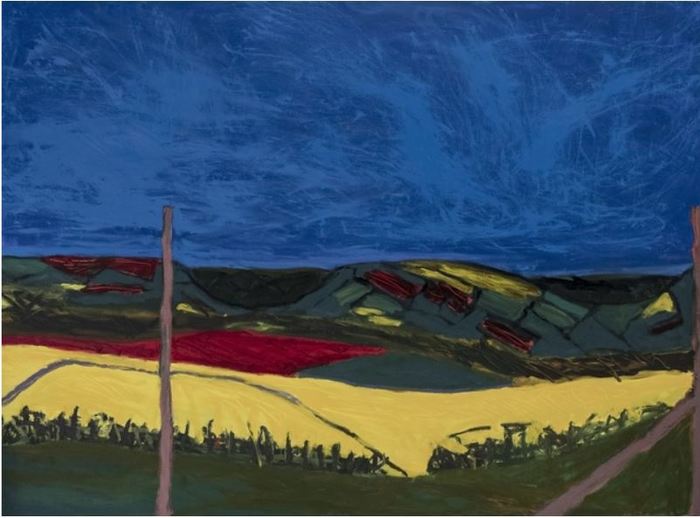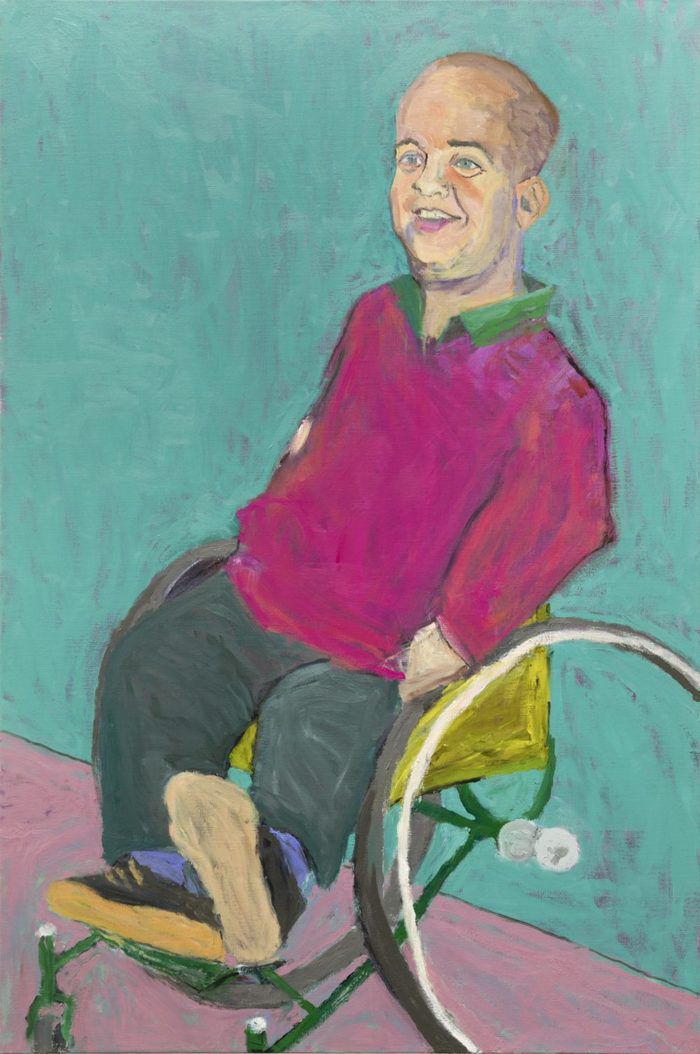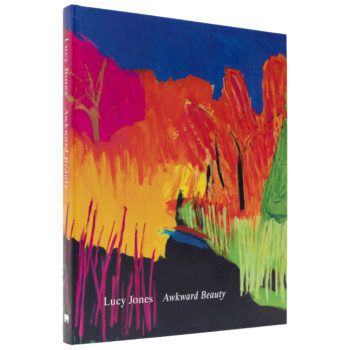Interview | Lucy Jones: An Awkward Beauty
by Ruby Fischer
Lucy Jones, 1996, oil on canvas
FROM beneath a mop of shaggy dark hair, a pale figure emerges from a
purple canvas (above), with the green of her skin giving way to a hard gash of a mouth which splits the face in two like a lopsided horizon.
It’s an uncomfortable painting. The coarse, bold strokes lead you back to the penetrating gaze but something in the expression behind those slate-grey eyes holds you transfixed. Before long, you start to realise you’ve
probably been staring too long. That canvas, Lucy Jones 1996, is an early example of how this artist deals with being looked at. Born with the cerebral palsy which affects her speech and movement, Jones’s work is hard-won, but steers well clear of sentimentality. Bold, energetic lines vibrate beside thick planes of vibrant colour, forcing her likenesses to emerge from their flat, desolate backgrounds to return the viewer’s gaze.
It is this raw quality which makes her such an extraordinary talent. Her portraits are at once intensely revealing and brutally candid, often featuring
mirrored text which forces the viewer to decipher its meaning— an everyday labour for Jones, who is also severely dyslexic.
A Handful of Tears, 2013, oil on canvas
Exquisitely observed and coursing with life, her robust landscapes immediately reveal a painter totally immersed in her environment. It’s there in the broad-backed hills, patchworks of colour setting the canvas ablaze with movement and in the royal blues and lemon yellows which streak across the image with the unique, muscular energy of her brushwork.
Talking to her after her recent show at the Flowers Gallery in London, she tells me that art became an important aspect of her life from her early years.
“When I was eight, I went to Byam Shaw for art classes and won my first prize,” she says. “My secondary school was filled with art. My sister Sarah
also persuaded me to see that somebody with my extensive problem with dyslexia might do better as an artist, so I did a foundation at Byam Shaw. After this there were many tutors who recognised me as somebody who was, and is, a painter.” She went on to get a first-class honours degree at Camberwell arts school and an MA from the Royal College, then to the Italian capital on a Rome scholarship. Yet, despite plenty of attention from the academic world, she soon realised that people were not going to be banging on the door of her Cable Street studio asking to exhibit her work.
But help in straddling the gap between art school and “the real world” came in the shape of the Arts Council buying some work and a glossy feature in the Mirror on Sunday and shows at Flowers Gallery.
“At the time it seemed to flow like a snowball rolling down a hill, collecting more snow as it goes,” she says. “I was in fact very lucky, a lot of serendipity.” Portraiture and landscape painting have “truly gone hand in hand,” she says. “At art school I would paint the model but also go out into the landscape, or rather Londonscape.”
There’s no particular landscape she has always wanted to paint: “I am just pleased if I can find a place to sit and to see over the hedgerow and do my
pen, ink and chalk drawings. Hard and awkward to do, they would take hours. I would make corrections with the chalk and use these to make large town-scapes using the bridges over the Thames.”
What she calls “awkward beauty” relates to much of her work, with titles of many of the self-portraits intentionally giving the viewer a sense of unease, she says. “I often write in mirror-writing on the painting making them literally difficult to read. And in some of the full-size self-portraits I am at eye level, with my head in the mirror and there is a weird distortion when looking down at my feet. “In these paintings I am trying to resolve the dichotomy
of this. There is of course an awkwardness to having cerebral palsy. The beauty comes through the drawing and the colour I use. And maybe the
landscapes are the other reflection of beauty, without words or a figure within them. “There is a tension between becoming too didactic, which a lot of work is nowadays, and the beauty of the language of paint which in the end must carry the painting.”
That language is shaped initially by using different media on paper but most of her work is in oils because they are rich in colour. Instantly recognisable for its extraordinary palette, what inspires her choice of colours relates very
much to the essence of her subject.
Hot Summer Sun, 2018, oil on canvas
“In last year’s landscapes, oilseed rape dominated. If you take the painting Hot Summer Sun (above), I used a sharp citrus yellow to start with. It would be hard to ignore the yellow, [it] had to be balanced with the dark blue of the sky which was too opaque and I scumbled a lighter blue over the sky so that the
tone of the blue related to the tone of the yellow. “I do not lose the truth of the reality of the landscape but it is ‘stretched’ as a Van Gogh landscape is.”
Tom Shakespeare: Intellect, with Wheels, 2017, oil on canvas
In her painting of Tom Shakespeare, Intellect, with Wheels (above), the subject wears grey trousers, “the ones that all schoolchildren wear” and it’s the key to the painting, with the grey balancing the other colours “so they sing.”
Jones has been producing images of herself for a long time and for her a truly good self-portrait “needs to encompass the wider idea of humility, the fact of allowing the gaze of other people to think about being looked at — being a woman, being a woman who moves awkwardly, being a woman with hidden difficulties, being part of the human race and confronting people to dare to look and see.”
Such sentiments are what make her work so relatable. Full of heart and humour, Jones’s painting rises at every level to its full expression and you can’t help but be transfixed by its awkward beauty.
■ *Lucy Jones’s portraits and landscape
paintings from the past 25 years are
available in the book Awkward Beauty,
published by Elephant in Association
with Flowers, £40.
Available from flowersgallery.com/shop.*
